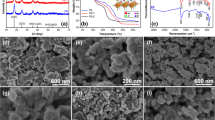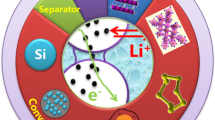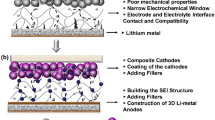Abstract
LaNi4.27Sn0.24 electrodes were characterized using electrochemical techniques at different alloy weights and binder contents. For a given alloy weight, the polarization resistance (Rp) increases with the state of charge (SOC). This arises due to changes from α to β phase at the alloy surface. The electroactive surface area for the hydrogen adsorption/desorption reaction changes with SOC and this also contributes to the variation of Rp. Since the interfacial area increases with alloy content, the polarization resistance decreases with increase in the alloy weight. An increase in the alloy weight reduces Rp and lowers the total resistance. The electrode utilization decreases by increasing the binder content and the electrode weight. A theoretical model is presented to study the effect of alloy weight and particle size on the electrode performance. The model simulations predict lowering of the utilization with increase in the electrode weight. The effect of particle size on the energy and power density of the electrode was also studied.
Similar content being viewed by others
References
T. H. Fuller and J. Newman, 'Modern Aspects of Electrochemistry', Vol. 27, edited by R. E. White, J. O'M. Bockris, B. E. Conway (Plenum Press, New York, 1993), p. 359.
G. Zheng, B. N. Popov and R. E. White, J. Electrochem. Soc. 143 (1996) 435.
G. Zheng, B. N. Popov and R. E. White, J. Electrochem. Soc. 143 (1996) 834.
N. Kuriyama, T. Sakai, H. Miyamura. I. Uehara and H. Ishikawa, J. Alloys Comp. 202 (1993) 183.
N. Kuriyama, T. Sakai, H. Miyamura, I. Uehara and H. Ishikawa, J. Alloys Comp. 192 (1993) 161.
N. Kuriyama, T. Sakai, H. Miyamura, I, Uehara and H. Ishikawa, J. Electrochem. Soc. 139 (1992) L72.
W. Zhang, M. P. S. Kumar, and S. Srinivasan, J. Electrochem. Soc. 142 (1995) 2935.
P. Agarwal, M. E. Orazem, A. Hiser, 'Hydrogen Storage Materials, Batteries, and Electrochemistry', PV 92-5, edited by D. A. Corrigan and S. Srinivasan (The Electrochemical Society Proceedings Series, Pennington, NJ, 1992), p. 120.
B. N. Popov, G. Zheng and R. E. White, J. Appl. Electro-chem. 26 (1996) 603.
G. Zheng, B. N. Popov and R. E. White, J. Electrochem. Soc. 142 (1995) 2695.
A. Zuettel, F. Meli and L. Schlapbach, J. Alloys Comp. 221 (1995) 207.
B. S. Haran, B. N. Popov and R. E. White, J. Electrochem. Soc. 145 (1998) 4082.
J. R. Macdonald (ed.), 'Impedance Spectroscopy, Emphasizing Solid Materials' (J. Wiley & Sons, New York,1987).
W. Tobias and L. G. Austin, Electrochim. Acta 14 (1965) 639.
Author information
Authors and Affiliations
Rights and permissions
About this article
Cite this article
Zheng, G., Haran, B.S., Popov, B.N. et al. Studies on metal hydride electrodes with different weights and binder contents. Journal of Applied Electrochemistry 29, 361–369 (1999). https://doi.org/10.1023/A:1003491625307
Issue Date:
DOI: https://doi.org/10.1023/A:1003491625307




